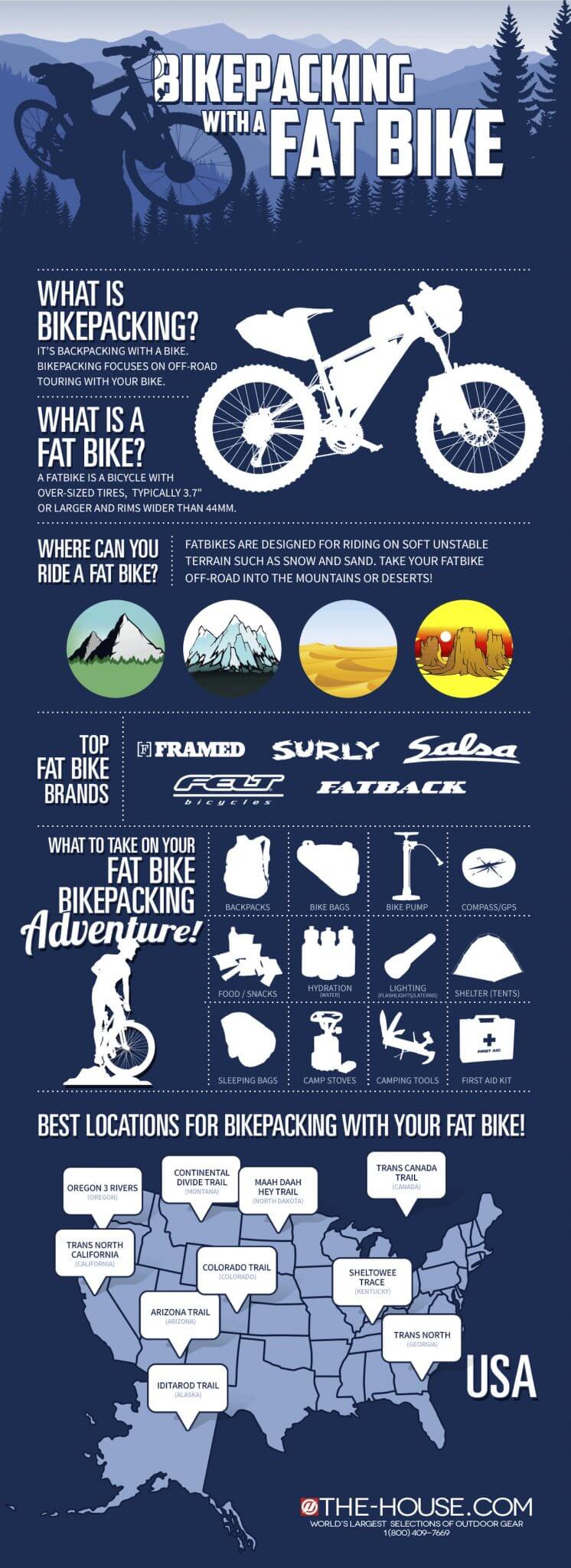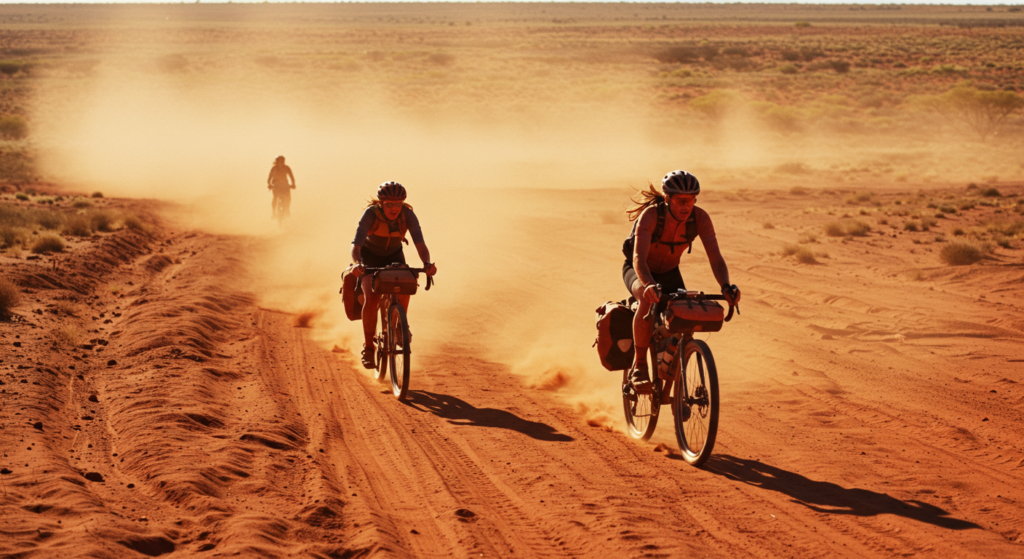Fat Bike Secrets Every Bikepacker Needs to Know
Exploring the Wild on Two (Fat) Tires
Imagine pedaling through towering sand dunes, crunching over snow-covered trails, or gliding across rugged mountain paths, all without worrying about getting stuck. That’s the magic of fat tire bikepacking! These beefy bikes, with their oversized tires and go-anywhere attitude, turn the entire world into your personal playground. Whether you’re carving through desert landscapes or braving the icy wilderness, fat bikes make adventure possible where traditional bikes would throw in the towel.
Fat tire bikepacking is all about freedom. You’re not confined to roads, groomed trails, or predictable routes, you make your own path. No pavement? No problem. Mud, sand, snow? Bring it on. With the right setup, you can load up your gear and set off into the unknown, ready for whatever nature throws your way. It’s about pushing limits, embracing the challenge, and discovering places few others ever reach.
But this isn’t just about the ride, it’s about the experience. There’s something special about being completely self-sufficient, carrying everything you need on your bike, and setting off on an expedition that’s equal parts thrilling and unpredictable. The crackle of a campfire at night, the sunrise over an untouched landscape, the joy of conquering a tough stretch of trail, fat tire bikepacking isn’t just a sport; it’s an adventure lifestyle.

Why Fat Bikes Rule the Trail
So why go fat when you could stick to a regular mountain or gravel bike? Because fat bikes are basically the monster trucks of the cycling world—they roll over obstacles, laugh in the face of deep sand, and turn snow-covered paths into smooth highways. Those chunky, balloon-like tires (usually 3.8 inches or wider) give you incredible stability, letting you tackle terrain that would send other bikes skidding.
And let’s talk about comfort. Fat bikes don’t just look cool; they ride like a dream. Those big tires act like built-in suspension, soaking up bumps, roots, and rocks so you don’t feel like your bones are being rattled apart. Forget stiff road bike rides or jarring downhill descents—this is smooth, buttery, all-day comfort. That means you can ride longer, explore further, and actually enjoy the journey instead of just surviving it.
Best of all? Fat bikes open up places you never thought possible. Traditional bikepacking usually means sticking to dirt roads or well-worn trails, but with a fat bike, you can ride on beaches, across frozen lakes, through dense forests, and over desert dunes. If you’ve ever looked at a map and thought, “I wonder if I could ride there?”, the answer is probably yes.
What You Need for an Epic Ride
Before you go charging into the wild, you’ll need the right gear setup. Fat bikepacking isn’t just about having a rad bike; it’s about making sure you have everything you need to survive (and thrive) out there.
First up: the bike. A solid fat bike with a sturdy frame (aluminum or steel for durability) and big, squishy tires is your foundation. Some come with suspension forks, but most riders rely on those monster tires to absorb the bumps.
Pro tip: Keep your tire pressure low (5–10 PSI) to float over soft terrain like sand and snow.
Next: packing strategy. Instead of bulky panniers, go for a streamlined bikepacking setup: frame bags, a handlebar roll, and a seat pack. This keeps your load balanced so you’re not wobbling like a drunk deer on rough trails. Carry the essentials, lightweight camping gear, a solid sleeping bag, and just enough clothing to handle whatever weather Mother Nature throws your way.
And don’t forget navigation and survival gear! A GPS device (or trusty old maps and compass), a water filtration system, and a repair kit are absolute must-haves. When you’re miles from civilization, being able to fix a flat, patch a torn tire, or find your way back to camp is the difference between an epic adventure and a cautionary tale.
The Best Fat Bikepacking Destinations

The world is your trail, but if you’re looking for the ultimate fat bikepacking spots, start with these:
- Great Sand Dunes National Park, Colorado – Ever wanted to ride across an endless sea of sand dunes? This is your chance. The rolling, ever-shifting terrain makes for a wild and surreal experience. Just make sure to bring extra sunscreen!
- The Iditarod Trail, Alaska – If you think winter is for staying indoors, think again. This legendary route, originally used for dog sledding, takes you through deep snow, icy rivers, and frozen tundras. It’s brutal, beautiful, and not for the faint of heart.
- The Australian Outback – Vast, dry, and incredibly remote, the Outback offers an epic fat bikepacking challenge. Follow ancient Aboriginal routes, cross stunning red sand dunes, and camp under a sky so full of stars it doesn’t seem real.
- Iceland’s Highlands – Volcanic landscapes, glacial rivers, and an otherworldly atmosphere make this a dream ride for adventurers. Just be ready for unpredictable weather – sun, wind, and freezing rain can all hit within the same hour!
Pro Tips for an Unforgettable Ride
Even the best riders can struggle if they’re not prepared, so here are some golden rules for fat bikepacking success:
- Tire Pressure Matters – Running your tires too firm is like trying to walk through deep snow in dress shoes. Lower your PSI to float over sand, snow, and mud.
- Sand or snow: Use a lower pressure (5–10 PSI) for better traction and a smoother ride
- Off-road or trails: Use a medium pressure (12–20 PSI) for balance between grip and stability
- Pavement or hard surfaces: Use a higher pressure (20–30 PSI) for reduced rolling resistance and improved efficiency
- Pack Smart – Less is more. Every extra pound slows you down, so only bring what you truly need. And for the love of all things adventure, balance your load so your bike doesn’t feel like a drunk shopping cart.
- Be Ready for Anything – Whether it’s a sudden snowstorm, a washed-out trail, or an unexpected wildlife encounter, expect the unexpected. That means bringing extra food, a solid repair kit, and a way to call for help if needed.
- Train Before You Go – If you’ve never ridden in deep sand or snow before, practice first. These terrains require different riding techniques, and you don’t want your first experience to be mid-adventure when you’re already exhausted.
- Respect the Wild – Pack it in, pack it out. Leave no trace. Fat bikes let you reach untouched places, so do your part to keep them that way.
Your Next Great Bikepacking Adventure Awaits
Fat tire bikepacking isn’t just about riding a bike; it’s about embracing pure adventure. It’s about taking the road less traveled (or no road at all), pushing past limits, and discovering just how far you can go. Whether you’re crossing deserts, conquering snowy trails, or pedaling through epic landscapes, a fat bike lets you go places no other bike can.
So what are you waiting for? Gear up, pick a destination, and start pedaling into the unknown. The adventure of a lifetime is just one ride away.

I am really enjoying the theme/design of your blog. Do you ever run into any browser compatibility issues?
A number of my blog visitors have complained about my blog not working
correctly in Explorer but looks great in Chrome.
Do you have any suggestions to help fix this problem?
Hey I know this is off topic but I was wondering if you knew of any widgets I could add to my blog that automatically tweet my newest twitter updates.
I’ve been looking for a plug-in like this for quite some time
and was hoping maybe you would have some experience with something like this.
Please let me know if you run into anything. I truly enjoy reading
your blog and I look forward to your new updates.
Hey there! Do you use Twitter? I’d like to follow you if that would be ok.
I’m definitely enjoying your blog and look forward to
new updates.